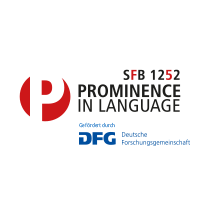A01 - ProPer: PROsodic analysis with PERiodic energy
Aviad Albert
The ProPer toolbox of acoustic analysis is a collection of open-source scripts and code that were developed in recent years by SFB 1252 post-doctorate researchers – Aviad Albert (A01), Francesco Cangemi (A02) and Mark Ellison (C09) – and the PI in the three mentioned projects, Martine Grice.
ProPer (standing for Prosodic Analysis with Periodic Energy) is a workflow that is designed to make novel tools for prosodic research available to the research community. The workflow is based on the open-source program R [1], capitalizing on its ever-growing universe of packages that provide state-of-the-art tools for visualization and computation (these include digital signal processing, data handling, plotting and statistics amongst other things). At the onset of the ProPer workflow, we also make use of the freely-available and widely-used program Praat [2], which we exploit for both its digital signal processing capabilities and its interactive handling of aligned textual annotations.
ProPer provides novel methods for prosodic studies as it allows the researcher to do away with discrete landmarks like F0 turning points. These crucial landmarks in traditional intonation research are often unavailable in spontaneous speech recordings, a problem that have led the intonation research community to prefer unnatural elicited speech with mostly sonorant consonants, in order to artificially reduce discontinuities in the F0 trajectory. In ProPer, however, the F0 trajectory is represented with two dimensions (quality/height as well as quantity/strength). This strategy allows us to achieve richer visual representations of the perceived pitch contour, as well as to quantify any portion of that contour directly from the interaction of the two continuous subcomponents. An example is presented in the Figure below: the F0 contour in the blue curve (top half of the plot) exhibits dynamically changing width to represent the strength of F0 (modulated by the red periodic energy curve at the bottom half of the plot). Furthermore, the color-coded numerical values within the syllabic intervals demonstrate the ProPer metrics that measure the pitch contour (∆F0 and Synchrony) and the prosodic weight (Mass) within each syllable. The green curve at the bottom half provides a visual representation of the dynamic speech rate.
The ProPer code is shared via a public GitHub repository, which is also included in ProPer's official Open Science Framework (OSF) repository [3], see where we also provide complementary materials. A growing number of published studies have already used the ProPer toolbox, either presenting the software itself (e.g. [4–5]), using it to investigate intonation patterns (e.g. [6–7]) or testing its validity compared to other tools [8].
References
[1] R Core Team. 2023. R: A language and environment for statistical computing.
[2] Boersma, Paul & David Weenink. 2023. Praat: Doing phonetics by computer.
[3] Albert, Aviad, Francesco Cangemi, T. Mark Ellison & Martine Grice. 2023. ProPer: PROsodic Analysis with PERiodic Energy. OSF.
[4] Albert, Aviad, Francesco Cangemi & Martine Grice. 2018. Using periodic energy to enrich acoustic representations of pitch in speech: A demonstration. In Proceedings of Speech Prosody. Poznań, Poland.
[5] Cangemi, Francesco, Aviad Albert & Martine Grice. 2019. Modelling intonation: Beyond segments and tonal targets. Proceedings of the 19th International Congress of Phonetic Sciences (ICPhS), 572-576. Melbourne, Australien.
[6] Sbranna, Simona, Caterina Ventura, Aviad Albert & Martine Grice. 2023. Prosodic marking of information status in Italian. Journal of Phonetics 97. 101212.
[7] Jeon, Hae-Sung & Stephen Nichols. 2022. Investigating prosodic variation in British English varieties using ProPer. In Proccedings of Interspeech. Incheon, South Korea.
[8] Roessig, Simon, Bodo Winter & Doris Mücke. 2022. Tracing the phonetic space of prosodic focus marking. Frontiers in Artificial Intelligence 5.
